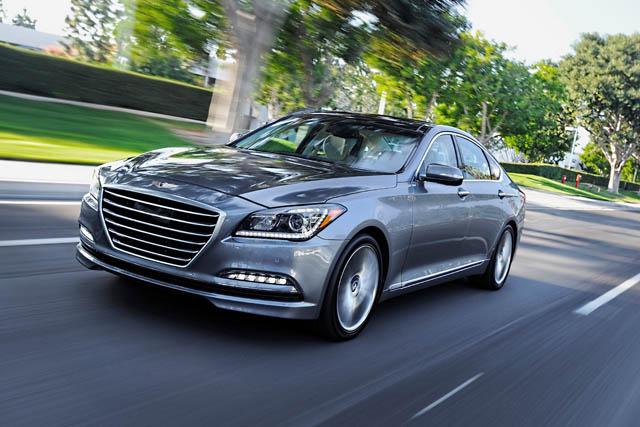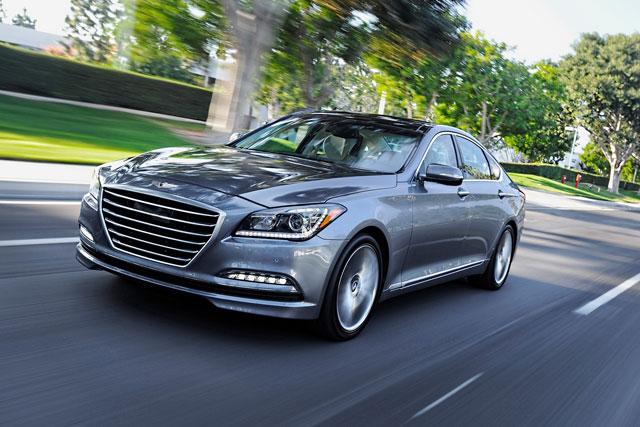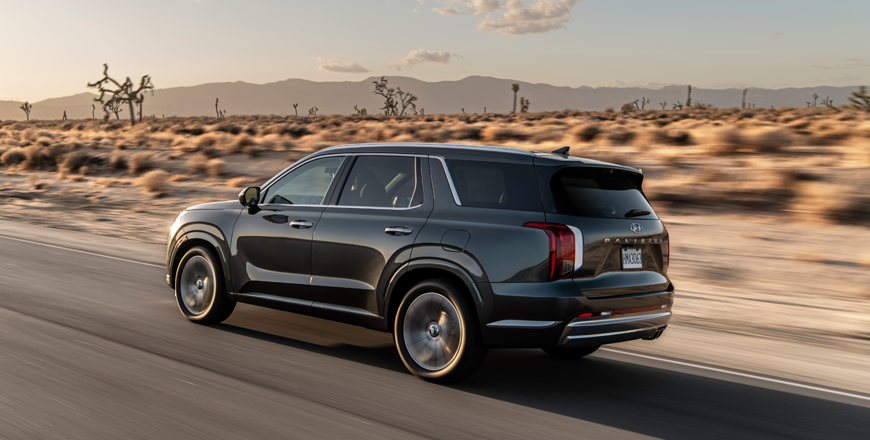You are here
Born again luxury
By Ghaith Madadha - May 12,2014 - Last updated at May 12,2014

First launched in 2008, the Hyundai Genesis took the automotive world by surprise and garnered many favorable reviews, mostly citing its comfort, kit, quality, refinement and value. A world class car that broke into the tough German-dominated executive saloon segment, the all new 2015 second generation Genesis builds on its predecessor’s credentials with greater emphasis on design, driving dynamics, cabin refinement and high-tech driver aids and infotainment systems. A larger and more luxurious car than the car it replaces, the new Genesis sports more deliberate design lines and a fancy new Genesis-specific emblem, but nevertheless remains part of the Hyundai brand rather than a separate luxury brand, like Lexus is to Toyota.
Sculpted presence
Only the brand’s second global market executive saloon and the first car since ex-Audi designer and current Kia president Peter Schreyer took over design duties at Hyundai as well, the new Genesis sports a more sculpted, chiseled and bold look. Dubbed Fluidic Sculpture 2.0, the new Genesis’ striking new aesthetics have a distinctly European flavour but without an immediately discernable sense of lineage. Undoubtedly attractive and classy with a sense of gravitas and presence, the new Genesis’ design language is set to carve out and acquire a greater sense of brand identity once it takes root and is joined by other new Hyundai models sporting similarly familial designs.
Wider, lower and longer than previous, the new Genesis features a longer wheelbase and bonnet, which along with a more formal and assertive design, lends a discernable sense of class and presence. With a broad and tall trapezoidal grille with horizontal slats to emphasise width, the new Genesis’ fascia is imposing and its silhouette indulgently luxurious. Lines and surfaces are more sculpted and sharp, with high-set wraparound lights, bold grille and a be-winged Aston Martin- or Bentley-like emblem sits above. With its broad shoulder and low flowing roofline the new Genesis looks hunkered down, with large 245/45R18 tyres and wide track conveys a sense of urgency, elegance, sure-footedness and a vague hint of premium segment arrogance.
Seamless and smooth
Offered with two, now-familiar direct fuel injection engines including a five-litre V8 and 3.8-litre V6, the Genesis’ entry-level engine develops 310BHP at 6,000rpm and 293lb/ft torque at 5,000rpm. Smooth, refined and progressive in delivery, the Genesis’ 3.8-litre six-pack revs seamlessly from idle to redline, and while it features good low-end torque and mid-range flexibility, its best work is done at its high end, as it urgently builds up power. With a smooth eight-speed ZF automatic gearbox, similar to versions used by an eclectic variety of vehicles from Dodge to Rolls Royce, the Genesis 3.8 benefits from terrific drive-train refinement, and downshifts responsively to dig deeper into its engine’s power reserves when brisk on-the-move motivation is required.
With its engine eager to be revved hard, the Genesis 3.8 moves briskly when one holds gears to access its high rev abilities. And while its closely spaced gearbox ratios may be set up with an eye on achieving smoothness and efficiency, the Genesis 3.8 can however sprint to 100km/h in 6.5 seconds and onto 240km/h, and also return 10.7l/100km combined cycle fuel consumption. Fitted with large and effective 345mm ventilated front discs with four piston calipers in front and 315mm discs with single piston calipers at the rear, the Genesis 3.8 brakes confidently and curtly, while a an optional sensor- and radar-based Autonomous Emergency Braking system can automatically apply the brakes if the vehicle ahead brakes suddenly.
Buttoned down
Having done so much so well with the previous generation Genesis and having mad huge strides in design, refinement, packaging, amenities, cabin comfort and quality and branding in recent years, Hyundai turns its hand to achieving vehicle dynamics and chassis improvements this time around. With a helping hand from one of the finest chassis-turning specialists in the world, British sports car makers and engineering firm Lotus’ input have yielded a marked improvement in how the new Genesis rides and steers. With a European-flavoured chassis, the new Genesis rides with a smooth and planted manner that feels Germanic in its reassuring high speed stability, while noise, vibration and harshness isolation is superbly refined.
Firmer riding that its supple predecessor, the new Genesis however doesn’t feel harsh, but instead feels settled, smooth and sure-footed, and over sudden crests, dips and expansion joints feels noticeably more buttoned down on rebound than before. With excellent body stiffness lending itself to improved handling, ride comfort and safety, the new Genesis feels rigid through corners and refined at speed. Significantly quicker at 2.55-turns lock-to-lock, the new Genesis steering is more firmly weighted and feels tight and direct but well-damped for negative feedback. Tidier into a corner, the new Genesis is poised and less susceptible to body roll despite a hefty 1,877kg mass, and feels balanced and predictable when exit a bend on throttle.
Classy quarters
Noticeably more up market, the new Genesis cabin is spacious and ergonomic, with highly adjustable steering and front seats and optionally adjustable rear seats. Fit and finish are classy and elegant, with dark matte wood grain panels and a sense of symmetry and functionality to dash, console and steering controls and instrumentation. Soft textures and stitched leather are plenty, while the chunky contoured steering wheel looks dignified, with large be-winged Genesis emblem and a cross-section designed to better suit driver grip. Seating is somewhat high, but front visibility is good, while storage spaces and boot space are accommodating. The boot even has an auto opening system, if one’s hands are full and can’t reach for the key.
A well-kitted and luxurious car with multi-zone climate control, puddle lamp, standard 14- and optional 17-speaker sound system, standard eight-inch (20.3cm) or optional 9.2-inch (23.4cm) front infotainment and rear multimedia screens, the 2015 Genesis also features a head’s up display projecting driving information onto the windscreen and a bird’s eye around view camera for added maneuverability in confined spaces. The genesis also includes a high beam assist function that detects oncoming cars and and controls the high beam, while a blind spot detection system warns of unseen vehicles when changing lanes. Driver aids also include adaptive cruise control to maintain a set distance with the car ahead, and a lane departure warning system.
SPECIFICATIONS
Engine: 3.8 litre, all-aluminium, V6-cylinders
Bore x stroke: 96 x 87mm
Compression ratio: 11.5:1
Valve-train: 24-valve, DOHC, variable valve timing, direct injection
Gearbox: 8 speed automatic, rear-wheel drive
Ratios: 1st 3.665; 2nd 2.396; 3rd 1.61; 4th 1.19; 5th 1.0; 6th 0.826; 7th 0.643; 8th 0.556
Final drive / reverse: 3.909:1 / 2.273
Power, BHP (PS) [kW]: 310 (315) [231] @ 6,000rpm
Specific power: 82BHP/litre
Power-to-weight ratio: 165BHP/ton
Torque, lb/ft (Nm): 293 (397) @ 5,000rpm
Specific torque: 105Nm/litre
Torque-to-weight ratio: 211Nm/tonne
0-100 km/h: 6.5-seconds
Top speed: 240km/h
Fuel economy, city / highway / combined: 13 / 8.1 / 10.7 litres/100km
Fuel capacity: 73 litres
Length: 4,990mm
Width: 1,890mm
Height: 1,480mm
Wheelbase: 3,010mm
Track, F/R: 1,628 / 1,659mm
Overhang, F/R: 845 / 1135mm
Aerodynamic drag co-efficient: 0.26
Legroom, F/R: 1,160 / 890mm
Headroom, F/R: 1,045 / 970mm
Shoulder room, F/R: 1,480 / 1,450mm
Boot capacity: 493 litres
Kerb weight: 1,877kg
Suspension: Multi-link, coil springs, active dampers, stabiliser bar
Steering: Electric assistance, rack & pinion
Lock-to-lock: 2.55 turns
Turning radius: 5.52 metres
Brakes, F/R: 4 pistons, ventilated discs, 345 / single piston, discs, 315mm
Tyres: 245/45R18
Related Articles
Introduced in 2008 as Hyundai’s first export executive saloon, the Genesis gambit paid off and took the largely German-dominated premium automotive segment by surprise. Garnering acclaim from the motoring press, the original Genesis was particularly well-received in the crucial North American market.
Having made huge sales and brand equity gains following the 2008 financial crisis as other automotive brands suffered, Hyundai are now at th
Launched in late 2019 as Hyundai’s big flagship SUV, the Palisade struck an assertive aesthetic tone combined with a capable engine, confide














